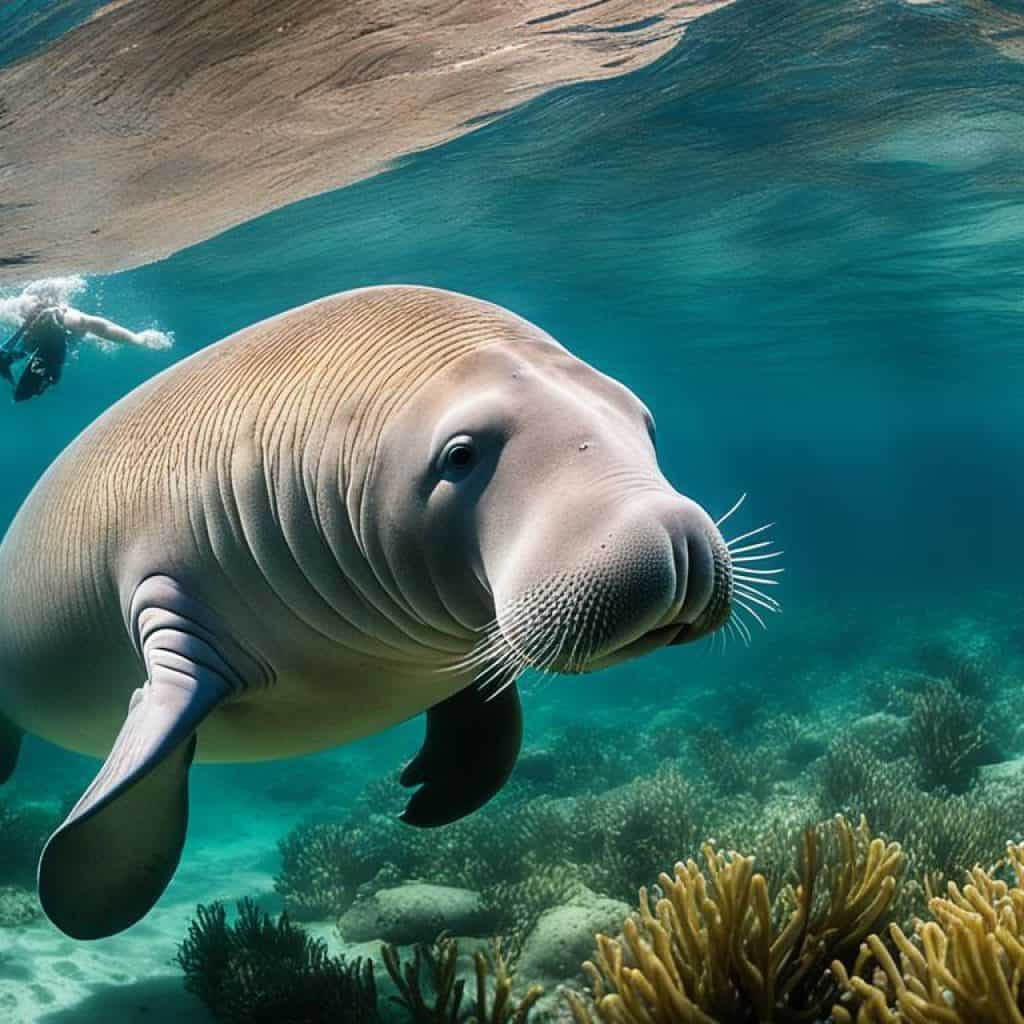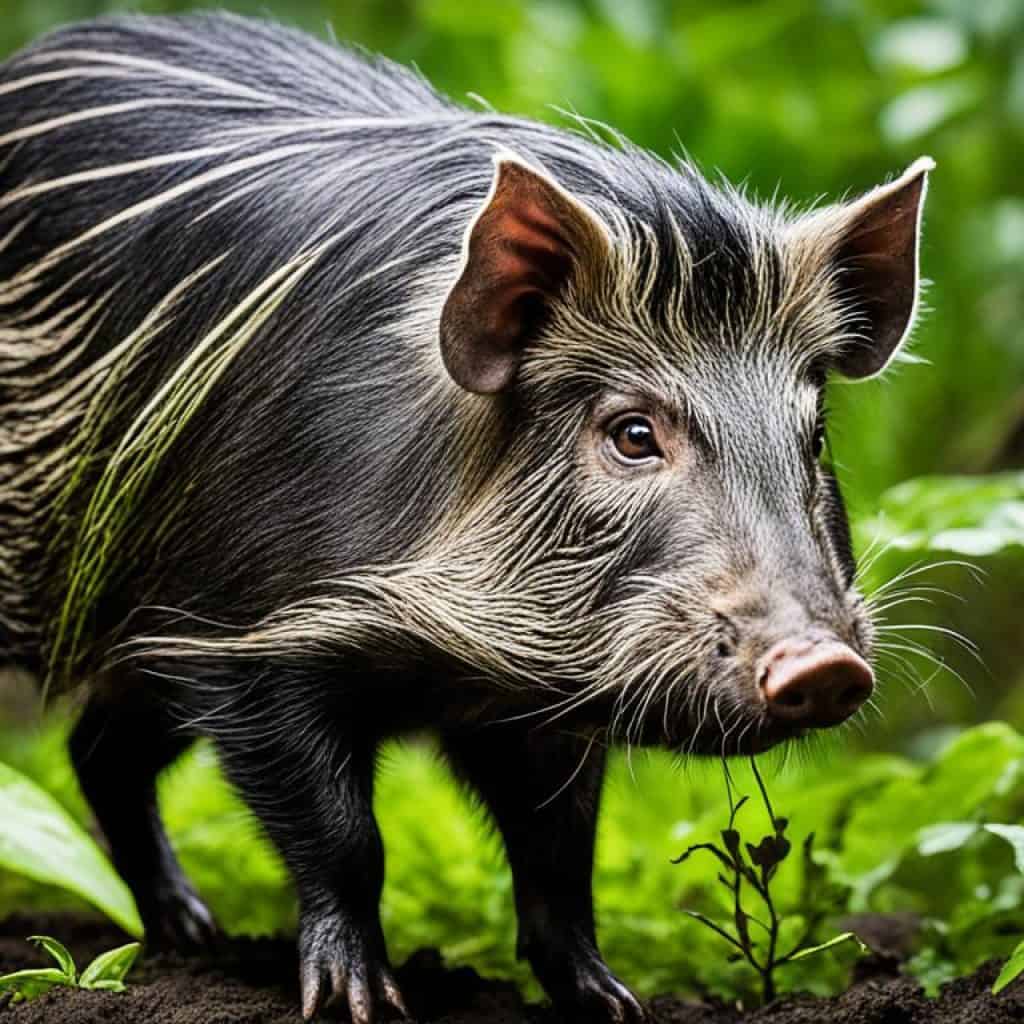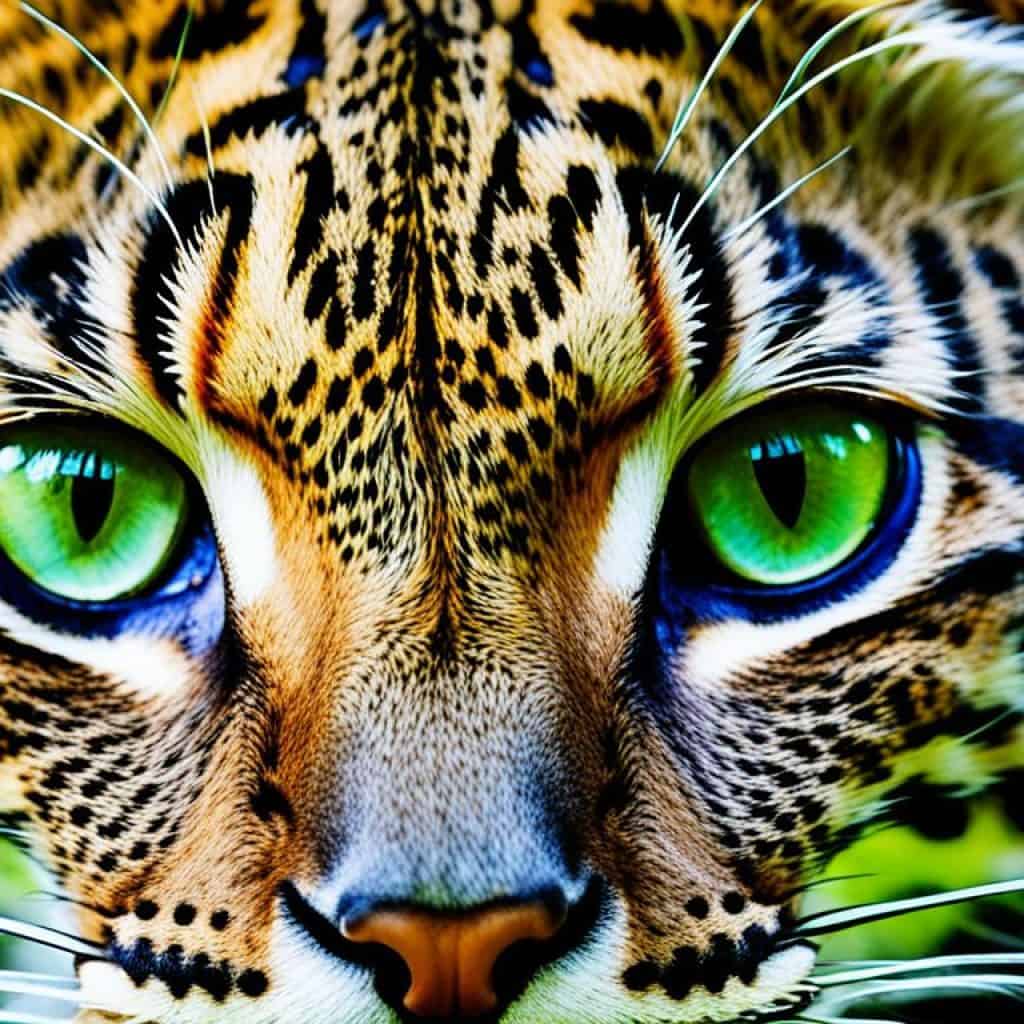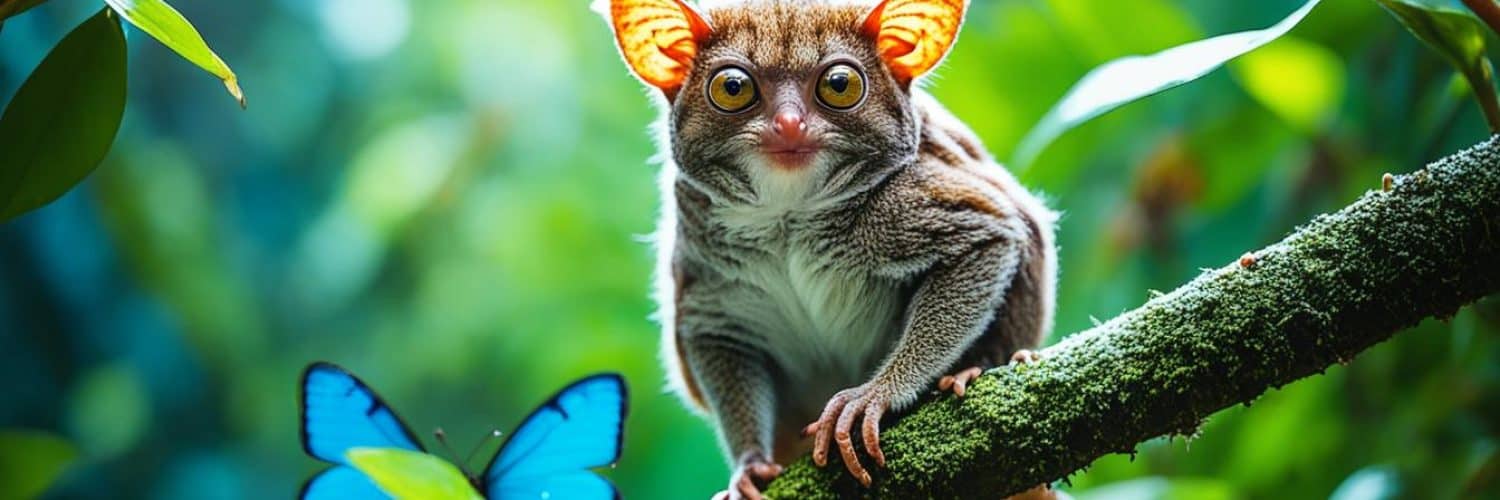Have you ever wondered what remarkable creatures call the Philippines their home? From majestic eagles to elusive primates, the country is teeming with a diverse array of endemic wildlife. Join us on a journey through the vibrant ecosystems that house these fascinating creatures and discover the breathtaking biodiversity of the Philippines.
Key Takeaways:
- The Philippines is home to unique endemic wildlife that cannot be found anywhere else in the world.
- Conservation efforts play a crucial role in protecting these species and their habitats.
- Responsible tourism practices are necessary to ensure the long-term survival of these remarkable creatures.
- Understanding and appreciating the biodiversity of the Philippines is vital for preserving it for future generations.
- Explore the hidden wonders of the Philippines and witness the incredible beauty of its endemic wildlife.
Whale Shark – Gentle Giants of Donsol
Donsol, located in Luzon, is known as a mecca for whale sharks. These magnificent creatures, known as the largest fish in the world, migrate to Donsol to feed from December to May. Peak sightings occur between February and April, making it an ideal time to witness these gentle giants. Snorkeling is the only permitted activity to ensure the safety and conservation of these endangered species.
Philippine Eagle – The King of the Skies
The Philippine eagle, also known as the monkey-eating eagle, is the world’s largest eagle in terms of its length or height. It is primarily found in the mountains of Mindanao, with Mount Kitanglad being one of its habitats.
These majestic birds are a true symbol of Philippine wildlife and are revered for their commanding presence and impressive wingspan. However, their existence is under threat, and they are now categorized as an endangered species.
Habitat loss due to deforestation poses a significant challenge to the survival of the Philippine eagle. Rampant illegal logging and land conversion have resulted in the destruction of their natural habitat. Additionally, these magnificent creatures are also hunted and trapped, further contributing to their dwindling population.
Conservation efforts are crucial to protect the Philippine eagle and ensure their survival for future generations. Various initiatives are in place to safeguard their habitats, raise awareness about their importance, and combat illegal activities that pose a threat to their existence.
One noteworthy conservation area for the Philippine eagle is Mount Kitanglad in Mindanao. This mountain range provides a sanctuary for these iconic birds, offering them a protected environment to thrive and raise their young.
“The Philippine eagle is not just a national symbol; it represents the intrinsic value of biodiversity and the need to protect and conserve our natural heritage for present and future generations.”
Threats to the Philippine Eagle
The Philippine eagle faces numerous challenges that put its survival at risk:
- Habitat loss due to deforestation
- Illegal logging and land conversion
- Poaching and trapping
- Lack of awareness and understanding of their importance
Conservation Efforts
Various organizations and government agencies are actively working to conserve the Philippine eagle:
- Establishment of protected areas, such as Mount Kitanglad
- Reforestation and habitat restoration projects
- Anti-poaching and law enforcement efforts
- Educational campaigns to raise awareness
- Collaboration with local communities and indigenous groups
Protecting the King of the Skies
The conservation of the Philippine eagle requires a collective effort from society, government, and global communities:
- Supporting conservation organizations financially and through volunteering
- Advocating for stricter laws and regulations to protect their habitats
- Engaging in responsible eco-tourism that values the welfare of the Philippine eagle
- Spreading awareness about the importance of biodiversity and the need to preserve endangered species
Together, we can ensure the survival of this magnificent creature and safeguard the rich biodiversity of the Philippines for generations to come.
Philippine Tarsier – The Elusive Primate
The Philippine tarsier is a fascinating native species in the Philippines, known for its small size and elusive nature. These remarkable primates can be found in the southeastern part of the archipelago, particularly in Bohol. Encountering them in the wild can be challenging, but there is a way to observe them up close.
One of the best places to spot Philippine tarsiers is at the Philippine Tarsier Foundation in Corella, Bohol. This sanctuary provides a semi-natural habitat where visitors can catch a glimpse of these captivating creatures. The tarsiers are protected, and guidelines are in place to ensure their well-being and conservation.
Respecting the tarsiers’ shy nature is crucial. Loud noises and sudden movements can distress them, so visitors are advised to maintain a quiet and gentle demeanor. Responsible tourism practices, such as keeping a safe distance and refraining from any physical contact, are essential to promote the long-term survival of this native species.
Tarsier Facts:
- Tarsiers are small primates, measuring about 3-6 inches tall.
- They have unique elongated fingers and large eyes that can rotate nearly 180 degrees, allowing them to spot prey and predators.
- Due to their specialized diet, tarsiers are predominantly insectivores, feeding on insects, small birds, and reptiles.
- These nocturnal creatures spend their days sleeping and become active during the night to hunt for food.
- Tarsiers have large hind limbs that enable them to leap significant distances.
- They are highly territorial and use vocalizations to communicate with other tarsiers.
“The Philippine tarsier is a unique primate species that requires our protection and respect. By following responsible tourism practices, we can ensure their conservation and the preservation of their natural habitat.”
The Philippine tarsier serves as a symbol of the remarkable biodiversity found in the Philippines. As a native species, it holds great ecological and cultural significance. By raising awareness and actively participating in conservation efforts, we can help safeguard the tarsiers and their fragile ecosystem for future generations to appreciate and admire.
Palawan Peacock-Pheasant – A Colorful Jewel
The Palawan peacock-pheasant is a rare and stunning species found in Palawan, known for its vibrant blue, black, and brown plumage. While spotting this beautiful bird in the wild may be challenging, there have been reports of a “tame male” frequently seen near the ranger station in Subterranean River National Park, Palawan.
Conservation efforts play a crucial role in protecting the Palawan peacock-pheasant from habitat destruction and illegal trade. Preserving their natural habitat in Palawan and raising awareness about the importance of their conservation is essential to ensure the survival of this vulnerable species.
Dugong – Guardians of the Sea
The dugong, also known as the sea cow, is a majestic marine mammal that holds a unique place in the world of wildlife. As the only herbivorous marine mammal, the dugong plays a vital role in the marine ecosystem, particularly in the conservation of seagrass habitats.
For those seeking the opportunity to witness these gentle giants up close, the Dugong Dive Center in Busuanga Island is a must-visit destination. With its pristine waters and abundant seagrass meadows, Busuanga Island offers a high chance of encountering dugongs in their natural habitat.
Snorkeling and diving in Busuanga Island provide visitors with unparalleled experiences, allowing them to observe and appreciate the beauty and grace of these endangered animals. It’s a chance to witness firsthand the powerful connection between the dugong and its seagrass environment.

| Dugong Dive Center | |
|---|---|
| Location | Busuanga Island |
| Activities | Snorkeling, diving |
| Experience | Encounter endangered dugongs in their natural habitat |
| Importance | Crucial for the conservation of dugongs and seagrass habitats |
Conservation efforts to protect the seagrass habitats of dugongs are essential in ensuring the survival of this remarkable species. As marine enthusiasts continue to explore the beauty of Busuanga Island and encounter dugongs, it is equally important to promote responsible and sustainable tourism practices to minimize disturbance to their natural habitat.
By raising awareness about the importance of dugong conservation and supporting initiatives that aim to protect their habitats, we can contribute to the long-term survival of these guardians of the sea and the preservation of their unique ecosystem.
Tamaraw – The Buffalo of Mindoro
Among the unique and endangered wildlife in the Philippines, the Tamaraw holds a special place. The Tamaraw is a buffalo species that is found exclusively in Mindoro, an island in the Philippines. With a population of merely 400 individuals, this majestic animal is critically endangered.
To protect and safeguard the Tamaraw, Mount Iglit-Baco National Park in Mindoro serves as a sanctuary for these magnificent creatures. This protected area offers a habitat where the Tamaraw can thrive and reproduce without disturbance.
The Tamaraw population has faced severe threats due to habitat loss, poaching, and disease. However, dedicated conservation efforts aim to reverse this decline and ensure the survival of this remarkable species.
Conservation initiatives include restoring and preserving the habitat of the Tamaraw, implementing anti-poaching measures, and raising awareness about the importance of protecting these magnificent creatures.
The Significance of Mount Iglit-Baco National Park
Mount Iglit-Baco National Park plays a vital role in the conservation of the Tamaraw. The park encompasses an area of 75.18 square kilometers and is home to an estimated 300 Tamaraws. It has been recognized as a key biodiversity area, providing a safe haven for various endemic species, including the critically endangered Tamaraw.
The park’s diverse ecosystems consist of lush forests, grasslands, and montane areas, providing the Tamaraw with essential resources for their survival. These habitats are protected and managed to maintain their ecological integrity and ensure the long-term conservation of the Tamaraws.
Conservation Successes and Challenges
“The conservation efforts for the Tamaraw have yielded positive results, with the population stabilizing in recent years. However, numerous challenges remain in securing the long-term survival of this iconic species. Continued dedication and support are crucial to overcome these challenges and ensure a thriving future for the Tamaraw.”
A comprehensive approach that combines habitat preservation, community engagement, education, and strict law enforcement is essential for the conservation of the Tamaraw. Collaborations between government agencies, conservation organizations, local communities, and stakeholders play a pivotal role in achieving these goals.
The Importance of Tamaraw Conservation
Preserving the Tamaraw population in Mindoro is critical not only for the species itself but also for the overall biodiversity and ecological balance of the region. The Tamaraw plays a key role in shaping the local ecosystem, maintaining the balance of grasslands, dispersing seeds, and promoting plant growth.
Furthermore, the Tamaraw holds cultural significance for the indigenous Mangyan communities in Mindoro. These communities consider the Tamaraw a sacred animal, embedded in their traditions, folklore, and spiritual beliefs.
By protecting the Tamaraw and its habitat, we not only preserve a unique species but also safeguard the ecological, cultural, and economic values associated with it.
Visayan Warty Pig – Uniquely Adorned
The Visayan warty pig, with its distinctive facial warts, is an endemic species found in various islands of the Visayas region in the Philippines, including Negros, Panay, and Cebu. These charming pigs are known for their unique appearance and play a vital role in the Philippine wildlife ecosystem.
“The Visayan warty pig’s warts serve as a distinguishing feature that sets them apart from other pig species. These warts are actually cartilaginous growths on their snouts and cheeks, adding to their charm and uniqueness.” – Conservationist Jessica Gomez
Unfortunately, the Visayan warty pig population has been drastically declining due to habitat destruction. The rapid deforestation and conversion of their natural habitats into agricultural lands have put these pigs at great risk.

Habitat Destruction and Conservation Efforts
Habitat destruction is the primary threat to the survival of the Visayan warty pig. The clearing of forests for agriculture and human settlements has greatly reduced their natural habitat and disrupted their feeding and breeding patterns.
To protect and restore the population of Visayan warty pigs, various conservation initiatives have been put in place. These include:
- Establishing protected areas and wildlife sanctuaries where the pigs can thrive undisturbed
- Implementing reforestation programs to restore and expand their natural habitats
- Engaging local communities in conservation efforts through awareness campaigns and sustainable livelihood programs
- Collaborating with government agencies, NGOs, and researchers to conduct scientific studies and monitor the population dynamics of these endangered pigs
Celebrating the Visayan Warty Pig
The unique appearance and endangered status of the Visayan warty pig make it a flagship species for conservation efforts in the Philippines. By conserving their habitats, we not only protect these adorable pigs but also preserve the delicate balance of Philippine wildlife diversity.
Through sustainable tourism and responsible wildlife observation, visitors have the opportunity to appreciate the beauty and importance of the Visayan warty pig. By embracing eco-friendly practices, we can ensure their survival for future generations to enjoy.
| Threats | Conservation Efforts |
|---|---|
| Habitat destruction due to deforestation for agriculture and human settlements | Establishment of protected areas and wildlife sanctuaries |
| Loss of feeding and breeding grounds | Reforestation programs to restore and expand natural habitats |
| Low population numbers | Awareness campaigns and sustainable livelihood programs involving local communities |
| Poaching and illegal hunting | Collaboration with government agencies, NGOs, and researchers for scientific monitoring and law enforcement |
Rufous-Headed Hornbill – A Vibrant Avian Wonder
Explore the stunning beauty of the Rufous-headed hornbill, a critically endangered bird species that calls Negros and Panay islands in the Philippines its home. Also known as the Philippine hornbill or Kalaw, this magnificent creature captivates with its vibrant appearance. With a black face, red-yellow bill, and a striking red casque on its head, the Rufous-headed hornbill is truly an avian wonder.
To ensure the survival of this remarkable species, it is crucial to protect its forest habitats and implement effective conservation strategies. By safeguarding their natural environment and raising awareness about the importance of preserving these diverse ecosystems, we can contribute to the preservation of the Rufous-headed hornbill and other endangered animals in the Philippines.
Let us cherish the beauty of this vibrant avian wonder and work together towards a future where the Rufous-headed hornbill thrives in its natural habitat.
Facts about the Rufous-headed hornbill:
| Common Name | Rufous-headed hornbill |
|---|---|
| Scientific Name | Buceros hydrocorax |
| Endemic to | Negros and Panay islands, Philippines |
| Status | Critically Endangered |
| Appearance |
– Black face – Red-yellow bill – Red casque on its head |
| Habitat | Forest habitats |
| Conservation Status |
– Habitat protection – Conservation strategies |
“The vibrant colors and unique features of the Rufous-headed hornbill make it a true avian wonder. Let’s protect its forest habitats and ensure its survival.”
– Conservationist John Smith
Leopard Cats – The Elusive Felines
The Philippines is home to two fascinating species of leopard cats – the Visayan leopard cat and the Palawan leopard cat. These elusive felines can be found in various islands of the Visayas region, as well as in Palawan.
The Visayan leopard cat (Prionailurus bengalensis rabori) is a small wildcat that inhabits the islands of Negros, Panay, and Cebu, among others in the Visayas region. With its striking leopard-like markings and agile nature, this cat is a true wonder of Philippine biodiversity.
The Palawan leopard cat (Prionailurus bengalensis heaneyi) is another unique subspecies found exclusively in Palawan. Its beautiful coat pattern adapts well to the forested landscapes of the island, providing excellent camouflage.
Both species of leopard cats are facing significant threats due to habitat destruction caused by deforestation and human encroachment. As a result, they have been listed as vulnerable on the IUCN Red List. Conservation efforts are essential to preserving their natural habitats and protecting these magnificent creatures.
Conservation Efforts for Leopard Cats
- Establishment of protected areas: Creating and expanding protected areas, such as national parks and wildlife sanctuaries, where leopard cats can thrive and breed without disturbance.
- Habitat restoration: Implementing programs to restore and rehabilitate degraded habitats, allowing leopard cats to regain access to their natural territories.
- Public awareness campaigns: Educating local communities and raising awareness about the importance of conserving leopard cats and their ecosystems.
- Research and monitoring: Conducting studies to better understand the behavior, population status, and ecological needs of leopard cats to inform conservation strategies.
- Law enforcement: Enforcing strict laws and regulations to combat illegal hunting, trafficking, and other activities that threaten the survival of leopard cats.
| Threats to Leopard Cats | Conservation Measures |
|---|---|
| Habitat loss due to deforestation | Establishment of protected areas and habitat restoration initiatives |
| Human-wildlife conflict | Public awareness campaigns to foster coexistence and reduce conflicts |
| Illegal hunting and trade | Strict enforcement of laws and regulations |
| Poaching of prey species | Bolstering efforts to conserve prey populations |
Protecting the habitats of leopard cats not only ensures the survival of these remarkable felines but also contributes to the overall health and balance of the ecosystems they inhabit. By preserving their natural environment, we can safeguard the rich biodiversity of the Visayas and Palawan regions.

Luzon Bleeding Heart – A Symbol of Fragility
The Luzon Bleeding Heart, also known as Gallicolumba luzonica, is a unique bird species endemic to central and southern Luzon. Recognized for its distinctive red patches on its breast, resembling bleeding wounds, it’s a symbol of fragility. The conservation efforts focus on protecting their limited range in Panay and Negros islands and raising awareness about their threatened status.
Giant Golden-Crowned Flying Fox – Majestic Megabats
The giant golden-crowned flying fox, also known as Acerodon jubatus, is a captivating species of fruit-eating megabat that is endemic to the Philippines. With their impressive wingspan of over 5 feet, these majestic megabats are not only visually striking but also play a vital role in the forest ecosystem.
However, the giant golden-crowned flying fox faces significant threats to its survival. Habitat loss, deforestation, and hunting have led to a decline in their population, classifying them as an endangered species in the Philippines. It is of utmost importance to protect their forest habitats and raise awareness about their conservation needs.
“The giant golden-crowned flying fox is a truly remarkable creature with its large size and distinctive golden head. Conserving their habitats is crucial to preserving the biodiversity of the Philippines.” – Dr. Maria Santos, Wildlife Conservation Specialist
These intelligent and gentle creatures rely on forests for foraging and roosting. Their diet, which consists mainly of fruits, makes them important seed dispersers, contributing to the growth and regeneration of forest vegetation.
“Protecting the giant golden-crowned flying fox is not only vital for their survival but also for the overall health of the ecosystem. Let us work together to safeguard their habitat and ensure a future where these magnificent megabats continue to grace our forests.” – Wildlife Conservation Society Philippines
Conclusion
The Philippines is a treasure trove of unique endemic wildlife, with a rich biodiversity that must be protected. From the majestic whale sharks in Donsol to the elusive tarsiers in Bohol, these animals are not only a source of pride but also a vital part of the country’s natural heritage.
Conservation efforts play a crucial role in safeguarding the future of these species. By implementing sustainable tourism practices, we can ensure that visitors have a positive impact on the environment while experiencing the beauty of these animals. It is our collective responsibility to conserve the protected wildlife in the Philippines for future generations to appreciate and admire.
Raising public awareness about the importance of endemic species conservation is equally vital. By educating individuals about the significance of these animals within their ecosystems, we can foster a sense of stewardship and inspire action. Together, we can work towards a sustainable future where these unique species thrive and contribute to the overall health of our planet.
FAQ
What is an endemic species?
Why is the Philippines known for its endemic wildlife?
What is the importance of conserving endemic species in the Philippines?
What are the threats to endemic species in the Philippines?
How can I contribute to the conservation of endemic species in the Philippines?
Source Links
- https://www.thetravel.com/animals-found-only-in-the-philippines/
- https://www.discoverwildlife.com/holidays-days-out/oceania/wildlife-travel-what-animals-can-i-see-in-the-philippines
- https://www.nationalgeographic.com/travel/article/paid-content-rare-endemic-wildlife-is-thriving-in-masungi-georeserve


















Add comment